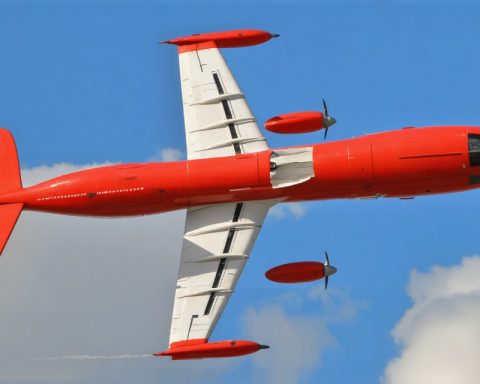- The final flight of the F-16 from Luke Air Force Base to Nellis marks the end of a significant era, concluding four decades of training thousands of pilots.
- Nicknamed “Vipers,” F-16s were central to Luke’s transformation into the world’s largest fighter wing, with 189 aircraft by 2005.
- Luke Air Force Base, operational since 1941, has evolved from training on P-40s and P-51s to hosting advanced fighter jets like the F-16 and now the F-35.
- The 309th Fighter Squadron played a crucial role in honing recruits into skilled pilots, essential for modern combat operations.
- With five F-35 squadrons now at Luke, the base continues its legacy of aviation excellence, advancing into the future of military air combat.
- The F-16’s legacy persists as a benchmark for new generations of pilots at various training bases across the U.S.
A sleek, formidable silhouette streaked across the Arizona sky—an F-16 Fighting Falcon taking its final flight from Luke Air Force Base to its storied new home at Nellis Air Force Base. This moment marked a poignant farewell, as Luke’s last U.S. Air Force F-16 departed, drawing the curtain on an epoch that spanned four decades and tens of thousands of trained pilots.
For years, these agile “Vipers,” as they are affectionately known, tore through the skies above Arizona, weaving a legacy of speed, might, and precision. Luke Air Force Base, an institution since 1941, started with the propeller-driven P-40 and P-51 and rapidly became a cradle for cutting-edge military aviation, evolving from the F-84 to the F-15. By 1983, the remarkable F-16 made Luke its training ground, transforming it into the world’s largest fighter wing by 2005, with an impressive fleet of 189 aircraft.
Beneath the sweltering desert sun, Lieutenant Colonel Michael Ress, a sentinel of the air, secured his visor and felt the F-16’s raw power surge around him for the squadron’s final flight. This epitomized the indelible role of the 309th Fighter Squadron—where raw recruits became adept pilots, enduring rigorous months of stress-filled transformation into the disciplined aviators needed for modern combat.
In the very corridors where students once pored over their unforgiving syllabus, anticipation grows as the F-35 takes center stage. This successor, bristling with advanced technology, propels Luke’s mission into its next chapter. Five F-35 squadrons now fill the base, continuing the storied tradition of refining the apex of aerial prowess.
As the F-16 departs, its influential legacy persists in moldings of new era pilots at bases like Morris, Holloman, and Kelly Field Annex. Still nestled in the flight paths of graduations past, Luke remains a Phoenix of airborne education—a site where even if the machines evolve, the caliber of courage and excellence takes flight anew.
While the F-16 may leave the Arizona skies, its rippling effect on air combat tactics and the soldiers it shaped continue to soar. As new pilots strap into the pilot’s seat of the future, guided by the echoes of the Fighting Falcon, Luke Air Force Base carries forward its unwavering commitment to training an elite cadre of aerial innovators. Here, the mission never ceases; it only ascends.
The End of an Era: What the F-16’s Departure from Luke Air Force Base Means for the Future of Military Aviation
A New Chapter in Military Aviation Training
The final flight of the F-16 Fighting Falcon from Luke Air Force Base marks the end of an era but also heralds a fresh phase in military aviation training. The F-16’s departure signifies the transition to newer technologies, represented by the F-35 Lightning II, which is now the centerpiece of training at Luke Air Force Base.
The Legacy of the F-16
The F-16, known as the “Viper,” left an indelible mark on military aviation, having been a cornerstone of pilot training since 1983. It has been a reliable and versatile aircraft deployed in various roles, from air superiority and ground attack to electronic warfare.
– Versatility: The F-16 is lauded for its agility and multifaceted capabilities, which have made it a staple in air forces worldwide. It has been exported to over 25 countries, with more than 4,500 units produced.
– Training Prowess: Luke Air Force Base, known for creating highly skilled pilots, has utilized the F-16 to foster a culture of excellence and precision. Over 18,000 pilots have been trained on this platform at Luke alone.
Transition to the F-35 and Advanced Training
The transition to the F-35 Lightning II brings advanced technology to the forefront of pilot training. The F-35 program at Luke Air Force Base will focus on maximizing the capabilities offered by this fifth-generation stealth fighter.
– Advanced Features: The F-35 boasts cutting-edge stealth technology, superior sensor fusion, and improved pilot situational awareness. It represents a leap forward in combat capabilities and training methodologies.
– Capacity Expansion: Luke currently hosts five F-35 squadrons, preparing to train pilots for the future’s complex battle environments, where networked warfare and data-driven tactics prevail.
Real-World Use Cases
The F-35’s integration showcases real-world use cases such as joint training with international allies, enhanced interoperability between forces, and the capacity to engage in a wide range of mission profiles from a single aircraft platform.
Industry Trends and Market Forecasts
– Global Interest: The F-35 program has garnered interest globally, with orders from multiple countries increasing its production pipeline. This surge is driven by the demand for advanced multirole capabilities in modernizing air forces.
– Tech Innovations: The emphasis on stealth, data-sharing, and artificial intelligence in the F-35 aligns with trends in military aviation towards more autonomous and networked platforms.
Security and Sustainability
– Security Enhancements: With advanced cybersecurity measures, the F-35 is designed to operate in contested environments, countering electronic warfare and hacking attempts effectively.
– Sustainability Efforts: As environmental concerns grow, modern military programs also consider sustainability, with the F-35 working towards improving its environmental footprint through better fuel efficiency and reduced emissions.
Controversies and Limitations
The F-35 program, while technologically advanced, has faced controversies regarding its high development costs and initial production delays. Critics argue that resource allocation might impact other essential defense initiatives.
Recommendations for Aspiring Pilots
1. Stay Informed: Understanding the technological shifts in military aviation is crucial. Keeping abreast of developments in aircraft like the F-35 can provide insights into future operational roles.
2. Adaptability: As aircraft technology evolves, so must the skillsets. Developing expertise in data analytics, cybersecurity, and systems engineering can be beneficial.
3. Global Perspective: With international alliances playing a significant role, gaining exposure to joint exercises and NATO courses can offer broader strategic perspectives.
For further insights into military aviation and pilot training, visit the U.S. Air Force official website.
The legacy of the F-16 continues to influence modern air combat tactics, and with the F-35 taking center stage, the future of military aviation training at Luke Air Force Base promises to be as innovative and impactful as its storied past.










